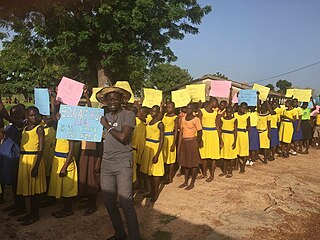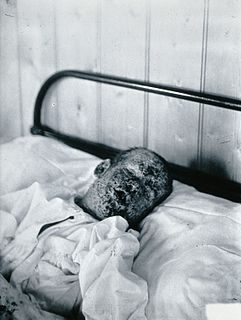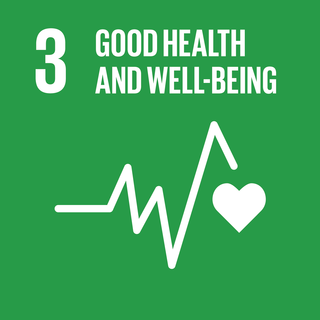
Universal access to education is the ability of all people to have equal opportunity in education, regardless of their social class, race, gender, sexuality, ethnic background or physical and mental disabilities. The term is used both in college admission for the middle and lower classes, and in assistive technology for the disabled. Some critics feel that this practice in higher education, as opposed to a strict meritocracy, causes lower academic standards. In order to facilitate the access of education to all, countries have right to education.

Clubfoot is a birth defect where one or both feet are rotated inward and downward. The affected foot and leg may be smaller than the other. Approximately 50% of cases of clubfoot affect both feet. Most of the time, it is not associated with other problems. Without treatment, the foot remains deformed, and people walk on the sides of their feet. This may lead to pain and difficulty walking.
Lepra is a UK-based international charity established on January 31st, 1924, working to diagnose, treat, and rehabilitate people with leprosy. Lepra currently works in India, Bangladesh and Zimbabwe.

Global health is the health of the populations in the worldwide context; it has been defined as "the area of study, research and practice that places a priority on improving health and achieving equity in health for all people worldwide". Problems that transcend national borders or have a global political and economic impact are often emphasized. Thus, global health is about worldwide health improvement, reduction of disparities, and protection against global threats that disregard national borders. Global health is not to be confused with international health, which is defined as the branch of public health focusing on developing nations and foreign aid efforts by industrialized countries. Global health can be measured as a function of various global diseases and their prevalence in the world and threat to decrease life expectancy in the present day. Estimates suggest that in a pre-modern, poor world, life expectancy was around 30 years in all regions of the world.

University of Iowa Hospitals and Clinics (UIHC) is an 811-bed public teaching hospital and level 1 trauma center affiliated with the University of Iowa. UI Hospitals and Clinics is part of University of Iowa Health Care, a partnership that includes the University of Iowa Roy J. and Lucille A. Carver College of Medicine and the University of Iowa Physicians group practice.

Jim Yong Kim, also known as Kim Yong (김용/金墉), is an American physician and anthropologist who served as the 12th president of the World Bank from 2012 to 2019. On January 7, 2019, he announced that he would step down effective February 1, 2019.

Neglected tropical diseases (NTDs) are a diverse group of tropical infections which are common in low-income populations in developing regions of Africa, Asia, and the Americas. They are caused by a variety of pathogens such as viruses, bacteria, protozoa and parasitic worms (helminths). These diseases are contrasted with the big three infectious diseases, which generally receive greater treatment and research funding. In sub-Saharan Africa, the effect of these diseases as a group is comparable to malaria and tuberculosis. NTD co-infection can also make HIV/AIDS and tuberculosis more deadly.
The International Disability Alliance (IDA), created in 1999, is an umbrella organization focused on improving awareness and rights for individuals with disabilities around the globe. The IDA works with Non Governmental Organizations (NGO's), supranational organizations such as the United Nations (UN), as well as state governments in order to create legislation, fund disability programs in developing and industrialized countries, and advocate for people with disabilities around the world. The IDA works very closely with the United Nations, and in particular they use the United Nations Convention on the Rights of Persons with Disabilities (UNCRPD) as their code of conduct.

Ignacio Ponseti was a Spanish-American physician, specializing in orthopedics. He was born on 3 June 1914 in Menorca, part of the Balearic Islands, Spain, Ponseti was the son of a watchmaker and spent his childhood helping repair watches. This skill was said to eventually contribute to his abilities as an orthopedist. He served three years as a medic during the Spanish Civil War treating orthopedic injuries of wounded soldiers. He left Spain shortly after the end of the war and became a faculty member and practicing physician at the University of Iowa, where he developed his ground-breaking, non-surgical treatment for the clubfoot defect - the Ponseti Method.
The Ponseti method is a manipulative technique that corrects congenital clubfoot without invasive surgery. It was developed by Ignacio V. Ponseti of the University of Iowa Hospitals and Clinics, USA in the 1950s, and was repopularized in 2000 by John Herzenberg in the USA and Europe and in Africa by NHS surgeon Steve Mannion. It is a standard treatment for clubfoot.

Eradication is the reduction of an infectious disease's prevalence in the global host population to zero.
Health care services in Nepal are provided by both public and private sectors and are generally regarded as failing to meet international standards. Prevalence of disease is significantly higher in Nepal than in other South Asian countries, especially in rural areas. Moreover, the country's topographical and sociological diversity results in periodic epidemics of infectious diseases, epizootics and natural hazards such as floods, forest fires, landslides, and earthquakes. A large section of the population, particularly those living in rural poverty, are at risk of infection and mortality by communicable diseases, malnutrition and other health-related events. Nevertheless, some improvements in health care can be witnessed; most notably, there has been significant improvement in the field of maternal health. These improvements include:

University of Iowa Stead Family Children's Hospital formerly University of Iowa Children's Hospital and Children's Hospital of Iowa is a pediatric acute care academic children's hospital located in Iowa City, Iowa. The hospital was founded in 1919 and its current facility, opened in 2017, overlooks the university's football home, Kinnick Stadium. The hospital has 190 inpatient pediatric beds and is affiliated with the University of Iowa Carver College of Medicine. The hospital provides comprehensive pediatric specialties and subspecialties to pediatric patients aged 0–21 throughout Iowa and is one of the only children's hospitals in the region and state. University of Iowa Stead Family Children's Hospital also features the only ACS verified Level 1 Pediatric Trauma Center in the state.
The current population of Myanmar is 54.05 million. It was 27.27 million in 1970. The general state of healthcare in Myanmar is poor. The military government of 1962-2011 spent anywhere from 0.5% to 3% of the country's GDP on healthcare. Healthcare in Myanmar is consistently ranked among the lowest in the world. In 2015, in congruence with a new democratic government, a series of healthcare reforms were enacted. In 2017, the reformed government spent 5.2% of GDP on healthcare expenditures. Health indicators have begun to improve as spending continues to increase. Patients continue to pay the majority of healthcare costs out of pocket. Although, out of pocket costs were reduced from 85% to 62% from 2014 to 2015. They continue to drop annually. The global average of healthcare costs paid out of pocket is 32%. Both public and private hospitals are understaffed due to a national shortage of doctors and nurses. Public hospitals lack many of the basic facilities and equipment. WHO consistently ranks Myanmar among the worst nations in healthcare.
CURE International is a Christian nonprofit organization based in Grand Rapids, Michigan. CURE's efforts are focused on providing medical care to children suffering primarily from orthopedic and neurological conditions. The organization's stated mission is "healing the sick and proclaiming the kingdom of God." The organization operates hospitals in Ethiopia, Kenya, Malawi, Niger, the Philippines, Uganda and Zambia. CURE also operates a pediatric specialty training program called CURE Neuro helping children with hydrocephalus and spina bifida survive and thrive through global partnerships. Since its inception, CURE Neuro has trained 41 surgeons from 23 low- and middle-income countries.
Unlike the flexible flat foot that is commonly encountered in young children, congenital vertical talus is characterized by presence of a very rigid foot deformity. The foot deformity in congenital vertical talus consists of various components, namely a prominent calcaneus caused by the ankle equines or planter flexion, a convex and rounded sole of the foot caused by prominence of the head of the talus, and a dorsiflexion and abduction of the forefoot and midfoot on the hindfoot. It gets its name from the foot's resemblance to the bottom of a rocking chair. There are two subcategories of congenital vertical talus namely idiopathic or isolated type and non-idiopathic type which may be seen in association with arthrogryposis multiplex congenital, genetic syndromes and other neuromuscular disorders.

The Catholic Medical Mission Board (CMMB) is an international, faith-based NGO, providing long-term, co-operative medical and development aid to communities affected by poverty and healthcare issues. It was established in 1912 and officially registered in 1928. CMMB is headquartered in New York City, USA, and currently has country offices in Haiti, Kenya, Peru, South Sudan, and Zambia.

Global HELP Organization (GHO) is a 501(c)(3) nonprofit organization working in the area of creating and distributing healthcare information for low-resource areas. HELP stands for "Health Education using Low-cost Publications". Founded in 2002 by pediatric orthopedist Lana and Lynn Staheli, GHO distributes information in the form of PDFs and videos online and through DVD libraries.
Mahadevappa Rampure Medical College (MRMC) is a private medical college in Gulbarga, Karnataka, India. The college is affiliated to Rajiv Gandhi University of Health Sciences, Bangalore.

Sustainable Development Goal 3, regarding "Good Health and Well-being", is one of the 17 Sustainable Development Goals established by the United Nations in 2015. The official wording is: "To ensure healthy lives and promote well-being for all at all ages." The targets of SDG 3 cover and focus on various aspects of healthy life and healthy lifestyle. Progress towards the targets is measured using twenty-one indicators.













